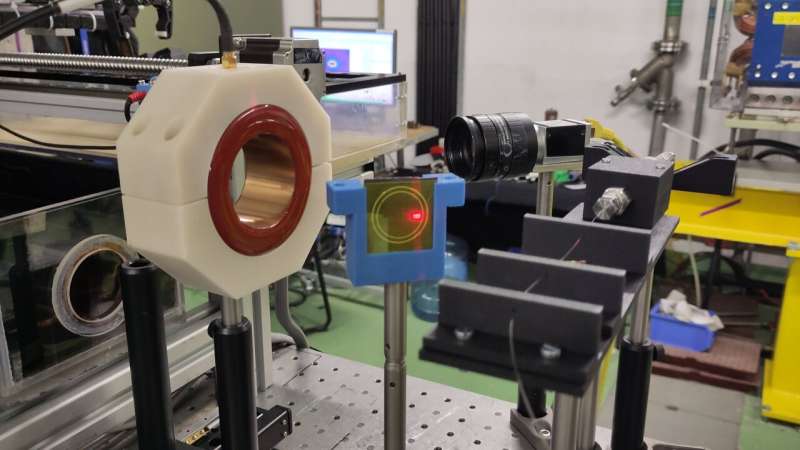Science
Hollow Glass Fiber Sensors Revolutionize Radiation Monitoring

A team of researchers at CERN has made significant advancements in radiation monitoring by testing hollow-core optical fibers in particle accelerator environments. These innovative sensors, no thicker than a human hair, have shown promise in enhancing the measurement of particle beam profiles and positions at the Super Proton Synchrotron, CERN’s second-largest accelerator, which plays a crucial role in experiments located in the North Area.
Innovative Design of Hollow-Core Optical Fibers
Unlike traditional optical fibers that guide light through solid glass, hollow-core optical fibers employ a microstructured design. This design allows light to travel through resonance and antiresonance effects on the electromagnetic field. By filling these hollow fibers with a scintillating gas—a substance that emits brief flashes of light upon interaction with particles—researchers can create effective radiation sensors. These sensors not only help adjust beam profiles and positions but may also facilitate real-time measurements of beam doses.
The development of these sensors is particularly vital as they can function reliably in extreme radiation environments. Current monitoring tools, such as multi-wire proportional chambers and scintillator detectors, often struggle under high-energy or high-intensity conditions, which poses challenges for both experimental physicists and medical applications, notably in techniques like FLASH radiotherapy.
Collaboration for Future Applications
Researchers at CERN are collaborating with medical scientists to explore tools that can withstand intense radiation. The FLASH technique, known for delivering radiation at ultra-high dose rates, necessitates innovative monitoring solutions due to its stringent beam conditions. By linking expertise in accelerator technology with medical research, the hollow-core optical fibers being tested may one day enhance the safe delivery of FLASH therapy to cancer patients.
The collaboration has already yielded promising results. In tests conducted at CERN’s facilities, including the CLEAR accelerator, a fiber filled with an argon-nitrogen mixture was subjected to exposure from an electron beam. Each time the beam traversed the fiber, the gas illuminated, transmitting a signal to a silicon photomultiplier, a sensor capable of detecting individual photons. The outcomes were presented at the recent International Beam Instrumentation Conference.
According to Inaki Ortega Ruiz, who oversees the beam instrumentation for the SPS North Experimental Area, “The fiber’s measurements of the beam profile closely matched those from a traditional YAG screen, a crystal that glows when struck by particles.” Remarkably, even after enduring a radiation dose sufficient to damage many instruments, the fiber demonstrated no degradation in performance.
While these initial results are encouraging, further research is planned to enhance the connection between the fiber and the detector, test sealed fibers pre-filled with gas, and investigate the long-term radiation hardness of these innovative sensors. The ongoing work at CERN not only highlights the potential of hollow glass fiber sensors but also underscores a significant step forward in both particle physics and medical applications.
-

 Entertainment3 months ago
Entertainment3 months agoAnn Ming Reflects on ITV’s ‘I Fought the Law’ Drama
-

 Entertainment4 months ago
Entertainment4 months agoKate Garraway Sells £2 Million Home Amid Financial Struggles
-

 Health3 months ago
Health3 months agoKatie Price Faces New Health Concerns After Cancer Symptoms Resurface
-

 Entertainment3 months ago
Entertainment3 months agoCoronation Street’s Carl Webster Faces Trouble with New Affairs
-

 Entertainment2 months ago
Entertainment2 months agoWhere is Tinder Swindler Simon Leviev? Latest Updates Revealed
-

 Entertainment4 months ago
Entertainment4 months agoMarkiplier Addresses AI Controversy During Livestream Response
-

 Science1 month ago
Science1 month agoBrian Cox Addresses Claims of Alien Probe in 3I/ATLAS Discovery
-

 Entertainment4 months ago
Entertainment4 months agoKim Cattrall Posts Cryptic Message After HBO’s Sequel Cancellation
-

 Entertainment2 months ago
Entertainment2 months agoOlivia Attwood Opens Up About Fallout with Former Best Friend
-

 Entertainment3 months ago
Entertainment3 months agoMasterChef Faces Turmoil as Tom Kerridge Withdraws from Hosting Role
-

 Entertainment4 months ago
Entertainment4 months agoSpeculation Surrounds Home and Away as Cast Departures Mount
-

 World2 months ago
World2 months agoCole Palmer’s Mysterious Message to Kobbie Mainoo Sparks Speculation













